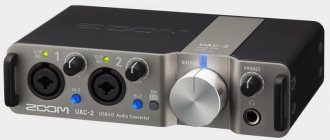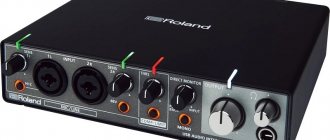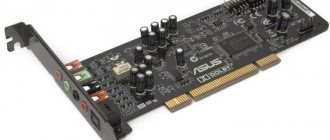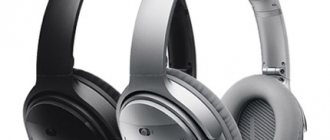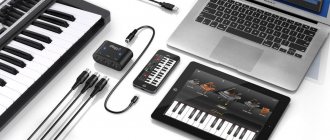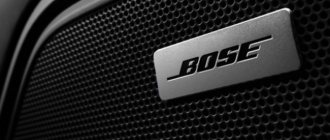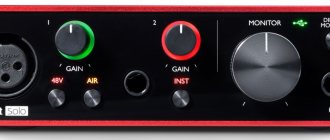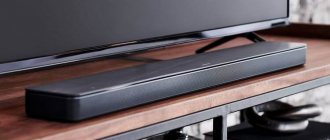Sergey Semikolenov
I tell you how profitable it is to buy in online stores
Good sound cards can turn your computer into a full-fledged home studio for recording and processing sound, unleash the full potential of expensive Hi-End headphones and speakers, and enjoy music in high quality.
Today, audio interfaces are not the preserve of professionals and sound engineers. They are purchased by everyone who is trying to improve the quality of their home entertainment, be it: playing the electric guitar, recording podcasts and YouTube videos, voice communication with friends, computer games or karaoke. It is worth understanding that an audio path integrated into a computer’s motherboard will never provide the same sound quality as even the most budget-friendly standalone audio interface. Therefore, we believe that internal and external sound cards are a Must Have to improve the quality of your leisure time.
We studied all the intricacies of audio interfaces, compared different models from companies, assessed the capabilities and best use of each device, and prepared a rating of the best sound cards for computers and music listening in 2022.
Best External Sound Card: BEHRINGER U-PHORIA UMC202HD
Budget card for recording, mixing and listening to music
Pros: optimal external sound card for creating an audio interface. Capable of being the center of your home studio, even if you are not involved in audio recording: suitable for all video makers, podcast creators, streamers and tiktokers.
On the body of the device there are two microphone combo XLR inputs (suitable for musical instruments, for example, a guitar with a jack connector), a source view button (switch between microphone and instrument level) and a Pad attenuator. There is separate amplification of the first and second channels, in the form of a Gain knob. The selection of the signal going to monitoring is carried out with a special button (in the off position the directive is cut off). For headphones, separate controls are implemented to change the gain and volume.
On the front side there is a USB output for connecting to a computer and a 48 V switch for condenser microphones and a stereo output on two jacks. The kit includes instructions for the device with special promotional codes for downloading free software from the manufacturer’s official website (more than 150 plugins and tools).
A good external sound card will become no less important an element of a home studio than a computer system unit. It will allow you to write sound with quality up to 24-bit with a sampling frequency of 192 kHz. The body is made of metal and according to the words, i.e. incredibly durable. The interface warranty is 3 years. A distinctive feature of the device is the input preamplifier, as indicated by the MiDAS inscription on the case. Compatible with Mac OS X, Windows XP and higher.
An external sound card provides the user with a high level of output signal, in which even professional sound engineers with premium headphones will not be able to find any extraneous noise or imperfections. The best solution for connecting analog audio recording devices and a computer without specific audio connectors. The price in the online store, in comparison with competitors of the same class, is 50% lower and amounts to less than 10,000 rubles.
Cons: monitoring only in one channel.
ESI U22 XT
Price is about 8500 rubles.
Has a metal body. Lacquered copper finish. The map was released in 2016.
The ESI U22 XT has separate controls for line output and headphone output. Instrumental Hi-Z TRS input.
Hardware FRONT-BACK switch. The choice of which signal to digitize - the front microphone + guitar inputs or the stereo RCA input on the rear panel.
Balanced TRS outputs, a solution initially designed more for studios.
ESI U22 XT does not require a separate network adapter and is powered from the USB bus. Very good. All you need to do is connect the cord to your computer. The interface works with phones and tablets as it supports UAC1 mode.
The TENOR TE7022L chip supports two channels and all modes up to 24-bit 96 kHz.
WM8776S stereo ADC 24 bit 96 kHz, DR 102 dB stereo DAC 24 bit 192 kHz DR 108 dB
Best External USB Sound Card: ESPADA PAAU003
Cheap audio card for PC or laptop
Pros: The most budget-friendly USB sound card in the ranking of the best audio interfaces of 2022. Despite the cost being equal to a cup of cappuccino from a good coffee machine, the device really works and produces clear sound without cracking or interference. Suitable for wedding presenters, cafe managers and anyone who wants to combine high equipment mobility with good sound.
ESPADA PAAU003 is suitable for computers, laptops based on MacOS or Windows, and even tablets. Runs on the Linux platform. In the systems, the device is well identified and does not disappear (unlike cheap Chinese cards). There are two analog channels. The case has an independent headphone output and a 3.5 mm jack microphone input. Supports 3D stereo sound.
The budget sound card is designed according to the Plug&Play principle - when connected via USB, no additional settings or connections are required, it is immediately ready for use. Data transfer speed – 12 Mb/s. The maximum DAC frequency is 48 kHz, with a 16-bit bit depth. Supports MME, DirectSound (output only). Weight is 27 grams.
Cons: Don't expect audiophile-level sound from it. For that kind of money (350 rubles) it’s worth considering a USB sound card as a temporary or spare one.
How it works?
Most sound cards use a DAC (Digital to Analog Converter) to convert digital audio signals to analog. The signal is output to conventional headphones and other acoustic devices. More advanced cards may include more than one sound chip to support high data rates and perform multiple simultaneous functions.
Best external audio card for a computer: Focusrite Scarlett Solo 3rd Gen
Great solution for recording from a microphone and listening to music
Pros: the third generation of sound card for the Scarlet Solo computer has a small, stylish all-metal orange body. The front and back panels are glossy. The potentiometers are made of high-quality plastic with good resistance - the movements are very smooth and clear. At the bottom there are grippy rubber feet.
The base has a built-in three-color indication of the incoming signal with overload display. The volume knob has a ribbed surface and is better than previous revisions: the grip is comfortable, adjustment is easy. All buttons have good feedback, and thanks to the glossy finish, the inscriptions are illuminated under the surface, creating the illusion of a screen. The colors are very soft, the font is thin, like on the latest iPhone models.
Connecting an external audio card to a PC is done using a USB Type-C connector. Balanced outputs replaced RCA. The front panel has an XLR input for microphones, a line-instrument jack, and Gain controls for each channel.
Nearby is a choice between an instrumental and a linear signal for the second input. It is worth paying attention to the inclusion of an additional 48 V power supply, activation of direct monitoring and a headphone jack. The Air button, which was the prerogative of more expensive models, when turned on, the signal is saturated with harmonics in the mid and high range.
Sampling frequency 192 kHz with a depth of 24 bits. The best external sound card for PC has high-quality preamps with low noise (even at maximum Gain values). The headphone amplifier is quite powerful; a comfortable level is achieved by turning the knob halfway. The third generation of the audio interface uses higher quality converters with good dynamic range in the budget segment: microphone input - 111 dB, main outputs - 108 dB. When you connect an expensive microphone preamplifier, it will pass in its pure form directly into the converters, avoiding unwanted coloration.
A computer sound card is a good option for those who do not know post-processing techniques, but want to get good results from recording. Users will appreciate the wide range of software included in the purchase package: Ableton Live Lite, plug-ins from Softube, Red equalizer and compressor, and a three-month subscription to the Splice sound library.
Cons: The glossy surface leaves fingerprints. One common volume for monitors and headphones, which can be inconvenient.
What is used in a PC to output an audio stream?
The built-in sound of modern motherboards and laptops significantly exceeds the auditory analysis capabilities of the average mentally healthy, technically literate listener.
The platform doesn't matter. Some motherboards have fairly high-quality integrated sound. Moreover, they are based on the same tools as in budget boards. Improvement is achieved by separating the sound part from other elements and using a higher quality element base.
And yet, most boards use the same codec from Realtek. Apple desktop computers are no exception. At least a decent portion of them are equipped with Realtek A8xx .
This codec (a set of logic enclosed in a chip) and its modifications are typical for almost all motherboards designed for Intel processors. Marketers call it Intel HD Audio .
Best Internal Sound Card: Creative Audigy Fx
A reliable solution for upgrading your computer
Pros: The best integrated sound card for PC from a reputable brand. It was with hardware that the development of Creative began, which is why it still occupies a leading position in this area. Creative Audigy Fx uses SBX Pro Studio technology and is capable of turning your computer into a 5.1 home entertainment system with surround sound.
The device will be an ideal choice for movie buffs, music lovers and computer game lovers. Connection type to the motherboard – PCIe. A multimedia sound card for a computer has a DAC that reproduces a 24-bit signal with a frequency of 192 kHz. The signal-to-noise ratio is 106 dB, which means that clear and interference-free sound will be output to the speakers.
The integrated amplifier allows you to connect headphones with a resistance of 600 Ohms. 5.1 channel outputs allow you to connect a multi-channel speaker system to create a home theater. Among the analog outputs there are: one Jack 3.5 (stereo) headphone output/Line-Out, two Jack 3.5 (stereo) Line-Out (rear, center/sub). Thanks to the presence of two independent jacks for line and microphone input, it is possible to connect two different audio sources to the computer.
Half-height allows the internal sound card to be installed in computer cases that only allow the use of low-profile expansion cards. SBX Pro Studio's real-time effects and intuitive downloadable interface let you customize your board and audio immersion to your liking.
Cons: not installed.
Summing up
This article covers the topic of the sound card, and repeatedly points out that the capabilities of the sound card and audio speakers, the entire audio system, affect the overall sound quality.
Many motherboards today have built-in sound cards, they are equipped with special chips, and the ports can be routed anywhere, depending on the design of the device. But you can use third-party sound cards and external audio devices, purchase and install them separately, although the capabilities of the built-in devices will probably be sufficient for people who are not sound fans.
- Forward
Comments
-6 profile 10.30.2018 21:31
Need cheap hosting? Try webhosting1st, just $10 for an year.
Reply Reply with quote Quote
Update list of comments
Add a comment
What is a sound card and what is it for?
What is an SSD? Solid State Drive
What is a processor, central processing unit, CPU?
What is a motherboard or system board and what is it used for?
What is HDD, hard drive and hard drive
What is RAM and Random Access Memory
Best external sound card for microphone: BEHRINGER U-PHORIA UM2
The most popular audio interface for home recording
Pros: a budget external sound card that is suitable for anyone who wants to record sound at home from a microphone, but is not ready to pay for expensive equipment. UM2 provides high-quality sound for reasonable money. It is difficult to find a device with similar characteristics, but at the same time cheaper than the BEHRINGER U-PHORIA series.
The compact body of the youngest in the BEHRINGER U-PHORIA UM2 line contains three regulators. The first is responsible for the sensitivity level of the microphone, the second for the sensitivity level of the line input, and the third regulates the level of the overall volume of the headphone output. The glossy front panel is equipped with an XLR/JACK 6.3 hybrid microphone jack, a JACK 6.3 line-in jack for connecting musical instruments (or a second microphone), a zero-latency direct monitoring button, 48 V phantom power indication, a stereo headset output, and an overload indicator.
On the front panel there is an output to a stereo RCA pair and a phantom power switch. The audio interface is connected via USB. XENYX microphone preamplifiers deserve special attention. The sound card is designed for professional sound recording of microphones, including condensers and all kinds of musical instruments. The card is especially popular among guitar players.
The audio interface is compatible with all well-known audio editors: Ableton Live, Cubase and ProTools. Recording is performed at a sampling rate of 48 kHz and an encoding depth of 16 bits. The device processes audio in streaming mode using two inputs and two outputs. At the same time, the latency level is extremely low. The device works with Windows and macOS. The driver is easily installed on your computer from the manufacturer’s official website; more than 100 different effects and plug-ins are also available there.
The gadget has a compact size, low cost and everything you need for recording in a home studio. Suitable for everyone who wants to get the highest quality sound with a good volume reserve. This popular sound card is ideal for recording microphones and guitars. The device will find use in computer games if you want to hear your opponent well.
Cons: not found
Expert opinion
In all of our blind tests, we were unable to detect any differences between 44.1 and 176.4 kHz or 16 and 24-bit recordings. Based on our experience, 16bit/44.1kHz ratio provides the best sound quality you can experience. The above formats simply waste space and money.
Downsampling a track from 176.4 kHz to 44.1 kHz using a high-quality resampler prevents loss of detail. If you get your hands on such a recording, change the frequency to 44.1 kHz and enjoy.
The main advantage of 24-bit over 16-bit is greater dynamic range (144 dB versus 98), but this is practically insignificant. Many modern tracks are in a battle for loudness, in which the dynamic range is artificially reduced at the production stage to 8-10 bits.
Best Embedded Sound Card: Creative Sound Blaster Z
Stylish board for modding enthusiasts
Pros: the device has been on the market for more than 6 years, but it still remains one of the best built-in sound cards in terms of price/quality ratio. High performance is ensured by a quad-core Sound Core3D sound processor with modern signal processing algorithms, including from a microphone. The PCI-Express connection interface is used. The sound card copes well with all home entertainment, provides good quality music listening and is ideal for gaming.
The top cover, made in the brand's signature orange color, is necessary to protect against electromagnetic interference. A headphone amplifier with a large power reserve is used (equipment with an impedance of up to 600 Ohms can be used). ASIO technology allows audio to be processed in real time with minimal latency. Particular attention is paid to the time-tested high-tech DAC – Cirrus Logic CS4398, which is used in top professional gaming cards. Good ergonomics are provided by a separate output for speakers and headphones.
The kit includes an external dual microphone, but the quality is no better than a smartphone headset. It can be used for communication and computer games. Thanks to the presence of two microphones and Crystal Voice technology, extraneous noise and sounds in the room are cut off. In the digital interface of the device, much attention is paid to various card settings for working with a microphone: in MMORPGs, you can change the timbre of your voice to roleplay a character. In general, the gaming orientation of the built-in sound card is felt - there are special presets for each genre of games. Stereo and 5.1 sound are supported.
Blaster Z performs better than top-end audio cards built into motherboards. Produces clear and detailed sound: complex compositions (orchestral or rock) do not merge into mush, but are revealed in a new way, compared to integrated analogues.
Cons: none identified
“Crystal Sound”: comparative testing of top-category sound cards
Creative Sound Blaster ZxR vs Asus Xonar Essence STX, May 2013
|
Choosing a high-quality sound card is one of the most popular and interesting topics on the iXBT Digital Sound forum and any other sound forums.
The problem of choosing a high-quality sound source can only be rivaled by the problem of finding suitable speaker systems. And if the “Crystal Sound” comparison is carried out regularly in terms of speakers, then in terms of sound cards we are just beginning our work. So, what could be easier than asking for advice on a forum? But even if you own one of the sound cards, it’s difficult to give advice on whether it’s worth buying. After all, ease of use and personal preferences are not the main thing here. The main thing in audio devices is sound quality. And it is poorly amenable to objective description and weighing by instruments, especially when the characteristics of the devices have reached the limits of the measuring equipment. What is the way out? The answer can be found, for example, in international recommendations for the examination of high-quality sound devices, recognized by all experts in the world, including us. It is necessary to compare the card with competing products and with the standard. Moreover, this must be done using the correct methodology, which would completely eliminate the expert’s bias. The task is impossible not only for the forum, but also practically impossible for ordinary media. This is a labor-intensive, costly and thankless task - why do it if there are easier ways to create materials? Correct objective examination of audio devices is only possible for leading publications that employ recognized specialists in the field of audio with specialized education who deal with audio on a professional basis. The assessment methodology must also be clear and open to the public.
Thus, we have combined all our 15 years of expertise in this area. But we don’t scare readers with tons of numbers and graphs in order to try to hide behind them, but provide only useful information from real life. Brief and to the point.
The Asus Xonar Essence STX sound card is already familiar to our readers from the article by Roman Kuznetsov.
Our editorial video in HD resolution tells about the new product Creative Sound Blaster ZxR (don't forget to click the "Original size" and "Full screen" buttons when viewing):
The main technical characteristics of sound cards that you need to know about:
| Creative Sound Blaster ZxR | Asus Xonar Essence STX | |
| Signal/noise (according to passport), dB: | 124 | 124 |
| Distortions (according to passport), % | no data | >0.0003% (−110 dB) |
| Line Out DAC | TI PCM1794 | TI PCM1792A |
| Signal/Noise DAC (according to passport), dB | 127 | 127 |
| DAC of multi-channel outputs | TI PCM1798 | absent |
| ADC | TI PCM4220 | Cirrus Logic CS5381 |
| OU | NJM2114, LM49710 | NJM2114, LM4562 |
| HP Amp | TI TPA6120A2 | TI TPA6120A2 |
| Capacitors | Nichicon Fine Gold | Nichicon Fine Gold |
| DSP | 4-core Creative SoundCore 3D | Asus AV100 (C-Media Oxygen) |
| Exits | ||
| Linear | RCA | RCA |
| Configuration | 5.1 (additional minijack outputs) | stereo |
| Headphone | large jack (1/4″ TRS) | large jack (1/4″ TRS) |
| Inputs | ||
| Linear | RCA | large jack (1/4″ TRS) |
| Internal AUX | No | There is |
| Microphone | large jack (1/4″ TRS) | No |
| Headset (microphone/earphone) | large jack (1/4″ TRS) + mini jacks (1/8″ TRS) on an external wired remote control | internal HD-Audio connector |
| Digital interfaces | ||
| exit | optic | electrical/optical |
| entrance | optic | No |
| Audio processing | ||
| Exit | Surround, Crystalizer, Bass, Smart Volume, Dialog Plus | Dolby Digital Live/Dolby Headphone/Dolby Virtual Speaker/Dolby Pro-Logic II |
| Entrance | CrystalVoice, Noise Reduction, Smart Volume Acoustic Echo Cancellation FX Focus | Karaoke, FlexBass, VocalFX |
| Game support | EAX 5 HD (128 voices) | GX 2.5 Game Audio Engine (EAX2.0) |
| Description link: | en.creative.com | www.asus.com |
| Retail price in Moscow: | 8000 rub. | 5600 rub. |
The Creative Sound Blaster ZxR card costs more, but is better equipped: there are 5.1 outputs, not stereo, and there is an external switching unit with a built-in stereo microphone.
The Asus Xonar Essence STX card appeared significantly earlier than the Creative ZxR. However, audiophile sound cards of this format have always existed. Among Creative cards we can recall Audigy 2 Platinum Pro, X-Fi Elite Pro, X-Fi Titanium HD cards.
The Sound Blaster ZxR is very similar to the X-Fi Titanium HD. For example, I completely adopted the DAC, op-amp and circuit design from this card. However, now Creative is not inferior to Asus in the presence of audiophile attributes: Nichicon Fine Gold, copper ground bus, metal screen, TRS output for Hi-End headphones. The technical effectiveness of these measures is close to zero. Here the manufacturer, rather, followed the expectations of the buyer. The championship in these attributes, however, belongs not to Asus, but to Onkyo cards from many years ago.
Creative Sound Blaster ZxR
This map was presented as a press sample. There may be minor changes in appearance and functionality in the final product. The model will go on sale in May 2013.
Set: main card, daughter card, wired control and switching unit, wires.
The card is the senior model of the new Z line. It is the best product released by Creative to date.
All modern cards, at the suggestion of one of the manufacturers, have a metal screen that is declared as protection against electromagnetic interference. You need to understand that this is purely a publicity stunt: for decades there have been professional boards without a screen, whose characteristics far exceeded those of gaming cards with screens, and the sound was much clearer to the ear. Moreover, a screen grounded at several points can play the bad role of non-zero mass and become a refuge for stray currents. Not to mention that deterioration of ventilation leads to an increase in thermal noise of semiconductors.
The best protection against interference is the absence of errors in the PCB layout and proper power supply. The screen, meanwhile, makes it much easier to install the card into the case. The risk of mechanical damage to board parts or static electricity discharge is eliminated. Removing the screen in the ZxR card is quite possible and not difficult. Unlike the Asus STX, the Creative card's screen does not contain threaded connections for the mounting plate bolts.
The external unit has parallel “large jack” and “minijack” connectors, which simplifies the connection of expensive headphones for music and computer headsets for Skype and other telephony. The Asus ROG Xonar Phoebus card has a similar external unit, but the card is significantly inferior to the Asus STX in terms of hardware and characteristics, being more comparable in price and features to the Creative Sound Blaster ZX.
On the board, noteworthy are the electromechanical relays for changing the modes of the headphone speakers and for switching the operating modes of the amplifier. This solution is preferable to electronic keys, since the impact on the signal is minimized.
The powerful TI TPA6120A2 headphone amplifier deserves special mention. It appears in both maps under consideration. Its use is completely justified and can only be welcomed. This is the proven most powerful amplifier with record low distortion. Implementing an amplifier using discrete elements will cost much more in terms of the price of components and will certainly increase the cost of development. TI TPA6120A2 has several operating modes, including an increased output voltage level for high-impedance headphones.
The new Creative map settings panel is made clear and has a choice of Russian and English interfaces. If you select English, the interface will use a higher quality and beautiful corporate font. Don't forget the important setting related to the headphone output. The 600 Ohm mode can also be set for headphones with an impedance of 250-300 Ohms, if they have low sensitivity.
The 192 kHz mode, which is again screwed to the side, caused complaints about the card. The card has something called Direct Mode, and the chip switches to this mode in a few seconds, with an obvious reconfiguration of the DSP. Hardware effects are not possible in this mode. The measurements are strange and show digital processing. According to information from the manufacturer, since the cards have just appeared on the market, the situation will improve with new drivers.
To be fair, 192 kHz is not a relevant frequency for most users. There are practically no sources of records in this format. The actual operating mode of DAC chips for all modes, be it 44, 48, 96, 192 kHz, is always the same, only the oversampling factor changes. In other words, recalculation always exists inside the digital filter of the DAC chip. Devices where the situation is different can be counted on one hand, and they cost completely different money. And since a higher frequency does not provide any advantage, like all games with digital recalculations and filtering, this still remains the lot of experimenters, in most cases operating at the level of self-hypnosis. While a banal, superficial replacement of an acoustic system with a higher-class model gives an incomparably greater return, and immediately and without subtle matters.
Asus Xonar Essence STX
The Asus Xonar Essence STX card has a slightly more attractive price, but both the equipment and functions of the card are significantly poorer. The card is stereo only, not 5.1. Does not have an external unit with microphones. The card's processor is essentially a stream switcher with a package of Dolby Digital software licenses. There is no hardware processing. Moreover, the AV100 version of the processor is the very first C-Media Oxygen, with a curved internal architecture and a fixed frequency of 48 kHz. Thus, the filling of the card raises numerous questions. A good idea for Asus would be not to sell a product with a relabeled dubious C-Media chip for many years in a row, but to rework it and release a normal new version. In newer Asus cards, many of the problems were overcome by switching to a new processor model. Why this model cannot be remade, refreshed, remains unclear to us.
This card has only two advantages: an excellent DAC and a low price.
The design of the control panel of the Asus card brings us greetings from the last century. The most interesting settings option is the HP Advance Setting tab, additional headphone output settings. There are 3 operating modes, depending on the impedance of the headphones. More modern Asus cards no longer have such a clutter of small elements. It is not clear what prevents you from rewriting the drivers.
Measurements in RMAA
Measurements in RMAA are not able to show the passport characteristics of cards, since in order to obtain a signal-to-noise ratio of 124 dB, a precision set of measuring equipment is required. In addition to this, it doesn’t hurt to have the simplest possible motherboard and a low-power passive power supply. However, where RMAA measurements are great is in instantly identifying flaws and design flaws.
We measured sound cards in RMAA in two computers. In the most powerful PC, packed with various peripherals, including on-board USB 3.0 and FireWire controllers, with great overclocking capabilities, and with a very powerful modern video card, measurements of both cards showed a signal/noise of 110 dB maximum. In another PC the numbers improved to 116 dB. Although a signal-to-noise level of an audio source greater than 100 dB is of no consequence, there is a definite relationship between the level of engineering of a device and the quality of the sound. The fact is that the signal/noise parameter and especially the signal/(noise+distortion) parameter of the DAC chip includes everything, including distortions modulated with the signal, which grow greatly with increasing energy saturation of the phonogram and become very audible. Different models of DAC chips are very well ranked in terms of quality by technical data.
So, Asus STX “distinguished itself” by noticeably increased noise in 44 kHz mode. In itself, this noise does not pose a danger to the listener, since it lies much lower than the TPDF dithering of a 16-bit signal, but it speaks of the legacy of the C-Media Oxigen chip, where there is a problem with 44 kHz support, which is solved by qualitatively recalculating the sampling frequency. For this reason, Asus provides data for its cards only in 48 kHz mode. Unfortunately, this mode is the least interesting for users. Changing the data supplied to the DAC to make life easier for the manufacturer is a simple trick that is a crime in a Hi-End product.
Creative ZxR, in turn, has no problems with frequency conversion in measurements, but has increased harmonic distortion of 0.0018% versus 0.0004% for Asus STX. Moreover, the nature of the distortion cannot be explained by either the op-amp or the DAC - their nameplate parameters are two orders of magnitude better. Also, measurements show that the ASIO driver on both cards is made rather clumsily. It feels like ASIO was added in a hurry, just for show in the technical specifications. Judging by the measurements, DirectSound is a good option for both cards under Windows 7 and 8. Of course, with the frequency set to 44.1 kHz in the properties of the Windows sound device.
You can download a free version of our RMAA program yourself and take your own measurements to determine the best playback method for your sound card and specific OS.
Expert listening
Listenings were carried out with both cards installed in one computer and instantaneous switching between the cards using a passive switch. For acoustics, we included Adam S2.5A studio monitors. The preparation and testing process was carried out with particular care and took several days. All wires and connectors were rechecked, card outputs were measured, all available drivers and different APIs (MME, DirectSound, ASIO) were tried in order to obtain the best measured results.
There were certain concerns that we might not hear the difference between sound cards, since the class of converters of modern sound cards is very high. For testing, we used professional sound cards based on CS4398 - E-MU1616M and LynxStudio Aurora 8. Fortunately, a serious approach yielded good results, and our fears were in vain - the difference between all cards is clearly audible on any musical composition. Moreover, a number of sound features have emerged that make the Creative Sound Blaster ZxR and Asus Xonar Essence STX very similar.
The sound of both gaming cards is at a very high level and is close to professional devices of the highest category. The E-MU1616M and LynxStudio Aurora 8 provide similar, denser, more spectral sound. The Creative Sound Blaster ZxR and Asus Xonar Essence STX sound with a slightly larger stereo panorama and are a little empty, but there is no timbral distortion or coloration in the sound. It is worth noting the attack and detail of the sound that captivates the listener, especially at high frequencies.
Are there any differences between Creative Sound Blaster ZxR and Asus Xonar Essence STX? The differences between the cards are small. Asus Xonar Essence STX has an advantage in sound, giving a little more detail. The difference is clearly revealed in double-blind testing, when an expert in a series of experiments indicates a more preferable device. We went further and tried to identify the relationship between sound quality and the selected sound API. The results are completely consistent with the RMAA data: the standard MME interface sounds the least advantageous. And the most terrible metamorphoses with sound are performed by the mode when the frequency of the file 44 kHz differs from the frequency of the Windows device, for example 48 kHz. This setting is located on the Advanced/Default Format tab.
For the headphone test, we took Beyerdynamic DT 990 Pro 250 Ohm and Sennheiser HD600. We didn't hear any difference in quality. Both sound cards - the Creative Sound Blaster ZxR and the Asus Xonar Essence STX - sound great: they produce very good, full-fledged sound with a large volume reserve. In most situations, setting the volume knob to 40-50% is enough. And if the Sennheiser HD600 are more universal headphones, with good sensitivity, and therefore less capricious to the sound source, then the Beyerdynamic DT 990 Pro sound quite inexpressive and quiet with a regular headphone output, and when you try to increase the gain, the sound still does not become full. Beyerdynamic requires increased voltage, and this is done specifically to extract the most undistorted sound from the structure, that is, from this membrane and the entire moving system. Hi-End headphone models with an impedance of 600 Ohms are twice as demanding in terms of voltage swing and headphone output power as 300 Ohm models. The headphone output requirements for high-impedance and low-impedance models conflict. That is why manufacturers have to either make different amplifier models, or install two separate outputs, or provide an impedance switch. The latter option is implemented in the tested Creative Sound Blaster ZxR and Asus Xonar Essence STX cards.
conclusions
Both Creative Sound Blaster ZxR and Asus Xonar Essence STX sound cards leave the impression of the manufacturing companies' first steps in the unusual category of Hi-End devices. These steps are clearly not completed. Some have succeeded, some have not yet succeeded.
As Asus and other manufacturers squeeze out, Creative is starting to lose the market. After the failure with Recon3D there is no time for jokes at all. Creative stops listening exclusively to its marketing “specialists”, seriously studies competitors’ products, collects user opinions and goes all-in. X-Fi production was completely discontinued a year ago, the page has been turned. In the new, full-fledged Sound Blaster series, starting with the lowest Z card, normal sound comes straight away. Sound Blaster ZxR is the quintessence of all Creative's capabilities, an attempt to combine the best: hardware effects, the needs of the average user and an uncompromising Hi-End ideology. Moreover, in a product that will still be affordable and will appeal to the mass market. According to reviews from the first mass owners of the new cards, sometimes people not even of the audiophile persuasion, the majority of buyers quite feel a significant increase in sound quality in headphones and speakers. This is precisely what explains the success of the Asus Xonar Essence STX. Users forgive all the shortcomings and clumsiness of this card just for the sake of high-quality sound in speakers and headphones. Although the Creative Sound Blaster ZxR has not yet succeeded in completely throwing the Asus Xonar Essence STX off its throne, Asus’ position at the current historical moment has become very weak. In practice, the choice in favor of Asus can be made only because of the slightly older model of the TI PCM1792A DAC chip, in order to have psychological confidence that the sound on high-end speaker systems will be a little better. Otherwise, the Creative card claims to be a leader, since it is superior to its competitor in everything, including due to the novelty of the model. Although Asus also has new card models, they are not interesting in this test due to their obviously worse sound.
Both cards - the Creative Sound Blaster ZxR and the Asus Xonar Essence STX - have design flaws that do not allow us to award the “Leader of the Class” award to any of the contenders. We advise manufacturers to stop adding external attributes in an attempt to outdo each other with the length of specifications, and start fine-tuning the existing functions.
Best Internal 5.1 Sound Card: Creative AE-7
Professional card for creating a home studio
Pros: The best built-in sound card for computer games and creating a 5.1 home theater. Thanks to the high fidelity of reproduction, a fundamentally new sound quality is ensured. The quad-core processor delivers rich sound without putting extra strain on your computer's CPU. Many users note that after installing the device, fps in games increased by 30%.
The ESS SABER class DAC installed on the card guarantees a pure audio stream of 127 dB DNR up to 32-bit at a sampling rate of 384 kHz. Such indicators are not provided by any internal sound card on the market in the segment up to 17,000 rubles. Of particular note is the Xamp two-channel headphone amplifier, which delivers power to each ear.
The system allows you to achieve soft sound, both while watching movies or listening to music, and while playing action games. Taking on an enemy by sound in shooters is no longer a fantasy. The Xamp amplifier allows the most demanding audiophiles to enjoy music: you can use headphones with an impedance of up to 600 Ohms, including Hi-End Magneplanars.
The Creative AE-7 supports 5.1 discrete audio and 7.1 virtual surround sound, so you can turn your room into an immersive cinema experience. The device works with Dolby Digital Live technology and DTS Connect encoding. Creative also took care of improving the sound - a whole package of tools has been implemented that are responsible for the immersion effect, improve the dynamic range and enhance low frequencies.
A few words should be said about the remote control of the sound card: it allows you to adjust the volume, has built-in 6.3 and 3.5 mm outputs, microphone and headphone inputs.
Cons: none identified
Colors of analog 3.5 mm sound card connectors
Most sound cards have ports for connecting speakers, microphones, and auxiliary devices. But there are also cards with more input and output ports designed for more advanced tasks.
Below are the most common audio connectors:
- Pink – microphone audio input;
- Light blue – linear audio input;
- Light green – linear audio output for the main stereo signal (front speakers or headphones);
- Orange – linear audio output for the center channel or subwoofer;
- Black – linear audio output for surround sound, usually the rear speakers;
- Gray – linear audio output for surround sound from side speakers.
There is also an additional gaming port - MIDI -15 pin connector for connecting additional audio devices.
Best external sound card for music: Steinberg UR22mkII
Good offer in terms of price/quality ratio
Pros: priced at just over 12,000 rubles. the user receives a full-fledged mobile recording studio with a USB, audio, and midi interface. The external sound card has accurate signal, clear tone and flawless dynamics. High sound quality is ensured by 24-bit resolution and 192 kHz sampling rate. The device housing contains modern and technologically advanced class “A” discrete microphone preamplifiers of studio level – Yamaha D-Pre. According to reviews from users and experts, they produce extremely detailed sound.
Advanced drivers support ASIO, WDM and Core Audio standards. Connection to all digital station applications is possible. MacBook and iPad owners will appreciate the ease of connecting the audio interface to Apple technology, as well as the availability of many worthy iOS applications.
The front panel has two inputs on combined XLR jacks with volume controls and peak LEDs. Moreover, each channel is equipped with a preamplifier. Thanks to the presence of switchable phantom power, it is possible to use both dynamic and expensive condenser microphones (power is turned on on the rear panel). The second input is switchable to high impedance or HI-Z mode, so the user can directly connect a guitar or other instruments.
On the right side of the front panel of the external sound card for music there are sound controls. The Phone knob controls the volume of the headphones, Output controls the volume of the total output signal to the speakers, and the MIX fader is necessary for the clearest possible balance of signals coming from the digital audio workstation and connected sound sources.
The rear panel has a midi input and output, which allows you to connect synthesizers, controllers, and drum machines. Power can be supplied either via USB or via a 5W rechargeable battery. UR22mkII is a mobile audio interface with ultra-rugged design and excellent performance.
Cons: none
Comparison test results
Unfortunately, time and equipment do not allow us to conduct our own comparative testing of various built-in and external solutions.
Therefore, let's take what has already been done for us. On the Internet, for example, you can find data on double internal resampling of the most popular discrete cards from the Creative X-Fi . Since they relate to circuitry, we’ll leave the check on your shoulders.
But the materials published by one large hardware project allow us to understand many things. In the testing of several systems, from the built-in codec for 2 dollars to the audiophile solution for 2000, very interesting results were obtained.
It turned out that the Realtek ALC889 does not show the smoothest frequency response, and gives a decent tone difference - 1.4 dB at 100 Hz. True, in reality this figure is not critical.
And in some implementations (that is, motherboard models) it is completely absent - see the figure above. It can only be noticed when listening to one frequency. In a musical composition, after properly setting the equalizer, even an avid audiophile will not be able to tell the difference between a discrete card and an integrated solution.
Best internal sound card for Windows 10 and 11: Creative Audigy Rx
With karaoke function
Pros: PCi-e internal sound card with EMU10K hardware processor and karaoke. The fifth generation has two microphone inputs and a powerful headphone output. A modern processor allows you to listen to music in 44 kHz mode without conversion. The eight-channel Cirrus Logic DAC provides clear sound and a card signal-to-noise rating of 106 dB.
The card's strongest point is its powerful headphone amplifier, which allows you to connect Hi-End monitors with an impedance of up to 600 Ohms to the card. The ability to connect 5.1 and 7.1 speakers to create a PC-based home theater has been implemented. Synchronization with an AV receiver via optical output is also possible.
It is worth highlighting the presence of two microphone inputs for karaoke and podcasts. Along with the sound card for streaming comes an updated control panel, where you can select various high-quality reverb presets. For online games, the function of changing voices (female, children, etc.) will be interesting.
The set includes a convenient karaoke player into which you can load mp3 files of songs with lyrics, change the tempo and pitch. You can sing in a browser on Windows 11 using specialized karaoke sites. For gamers, high-quality 3D sound is implemented in games, which is especially important in shooters and MMORPGs.
Cons: none
Creative X-Fi Surround 5.1 Pro
Price is about 5000 rubles.
Creative is one of the leading sound card manufacturers. Moreover, at the dawn of sound computers, Creative even formed the first sound card standard.
But in the class of top sound cards, Creative's success has always been very modest. Creative mainly focused on a more mainstream audience and gamers.
We present this sound card due to its not entirely standard solution. Sometimes it is very convenient when the card has a full-fledged remote control. And the large volume knob is very good.
For information who is interested, the article is about remote controls for controlling any cards from a PC.
The bad thing is that it's 5.1. Someone might need this. But the linear inputs turned out to be mini-jacks.
DAC/ADC 24 bit / 96 kHz. It should be taken into account that usually for such cards in 5.1 mode the 24 bit / 96 kHz stream is divided by the total number of channels. ASIO 2.0.
In those. The data indicates compatibility with Windows XP SP2 and higher. Which sounds very strange for 2022. Apparently, the fact that the card is selling successfully is now due to the presence of a remote control.
Best external sound card for laptop: Focusrite Scarlett 2i2 3rd Gen
High-quality audio interface for guitar recording
Pros: the second oldest model in Focusrite's updated line of third-generation sound cards. Among the external changes, we can highlight a new compact all-metal body, which has lost the small grooves that constantly clog with dust. It is now painted in a stylish orange metallic color.
The major upgrades are on the technical side, with balanced outputs, high-performance instrument inputs and converters, and third-generation natural-sounding mic preamps with a special Air mode. This feature changes preamp frequencies slightly, simulating the acoustic characteristics of traditional transformer-based devices. The result is an open and bright sound for instruments and vocals.
All interface controls are duplicated in the Focusrite Control application, which is very convenient. The manufacturer has taken care of newcomers to the world of audio: thanks to the QuickStart software tool, anyone can set up recording and playback in just a couple of minutes. After purchase, a whole range of recording software and plug-ins becomes available to the user.
Both channels of an external sound card can be microphone, instrument and line, which significantly expands the scope of application and work with the interface. In-device monitoring is direct, with zero latency. It is possible to pair them with 250 Ohm headphones; by the way, they have their own volume control on the front panel. The sound is recorded in 24-bit/192 kHz quality.
The main areas of application for a good sound card for a laptop: first of all, recording vocals, guitars and keyboards at home, and streaming. It is possible to use the device for broadcasting with background music. It is worth noting that the device works perfectly with Apple laptops and other equipment running macOS (no additional installations are required).
Cons: you cannot connect midi equipment.
From the history
In the past, computers could produce signals using a narrow range of frequencies as warning signals. With the growth of multimedia comes the need for high quality audio for entertainment and professional reasons.
The Adlib sound card has become a pioneer in these areas. It provided a more natural sound than the Creative Music System released around the same time in 1988.
The introduction of Sound Blaster sound cards by Creative Labs greatly increased their capabilities, allowing digital audio recording and playback. Therefore, Sound Blaster can be called the first sound card that made digital audio possible.
This increase in functionality led to the multimedia evolution of computers and audio-enabled programs created for them. Audio quality continues to evolve in terms of hardware and software.
Modern audio cards can provide higher quality 3D surround sound output. Computer programs and games are developed to take full advantage of their capabilities and satisfy human needs.
Best external sound card for headphones: Creative SB Play! 3
For high-quality sound amplification on a smartphone
Pros: The external USB sound card is a 3-in-1 device. Firstly, it is a high-quality DAC with 24-bit parameters and a quantization frequency of 96 kHz. Secondly, this is an excellent headphone amplifier that is suitable for devices with impedance up to 300 Ohms. Therefore, it is possible to connect studio monitors. The last use of the gadget is full-fledged work with headsets.
Podcast users will appreciate the built-in ADC for microphone operation. It supports 24-bit/48 kHz resolution. On the body of the device there are two Jack 3.5 connectors (one for a microphone, the other for headphones), the connection to a computer or laptop is via USB. A special adapter allows you to synchronize the device with mobile equipment and smartphones, reaching a new level of sound from familiar equipment.
You will get beautiful high-resolution sound, with a balanced character and well-developed high frequencies without a raised midrange. Bass lovers will get everything in full - saturation, depth, energy and velvety.
Control Panel software achieves a high level of audio realism and offers the user immersive sound effects. In addition, here you can find optimized profiles for selected headphone models. The main use area for an external sound card for headphones is listening to music, computer games and watching movies.
Cons: not found
Expansion cards
Expansion cards - or expansion modules - are additional units designed for self-installation into a computer or professional audio equipment of your choice. For example, expansion cards are often used for a computer, which allow the transfer of data in FireWire or Thunderbolt formats, which we talked about earlier. For professional equipment, they are also used to expand the functionality of a particular equipment.
Best Budget Sound Card: ESPADA PAAU005
The best portable audio card under 500 rubles
Advantages: budget solution for buyers of an external sound card. The current cost in online stores does not exceed 500 rubles, so it can be considered as a pocket backup audio interface. Many users use the device as a cheap alternative to a blown sound card in a laptop.
The case is made of iron, the connection to a PC or laptop is via USB. The “Plug&Play” principle allows you to start using the device after synchronization, without downloading and installing additional drivers. Windows 98 and above, Linux and macOS are supported.
There is an analog microphone input (3.5 mm jack) and an analog headphone output. Device dimensions 40x25x10 mm. In sound recording tests, experts did not identify any extraneous noise, crackling or whistling, even when using a budget headset.
Disadvantages: you should not expect a sound card cheaper than 1000 rubles. Hi-Fi sound.
Realtek audio quality measurements
The implementation of audio interfaces largely depends on the motherboard manufacturer. High-quality specimens show very good figures. For example, RMAA test for the Gigabyte G33M-DS2R :
Frequency response unevenness (from 40 Hz to 15 kHz), dB: +0.01, -0.09 Noise level, dB (A): -92.5 Dynamic range, dB (A): 91.8 Harmonic distortion, %: 0.0022 Intermodulation distortion + noise, %: 0.012 Channel interference, dB: -91.9 Intermodulation at 10 kHz, %: 0.0075
All the figures obtained deserve the ratings “Very Good” and “Excellent”. Not every external card can show such results.
Best external audio card for electric guitar: BEHRINGER U-PHORIA UMC22
Budget option for beginning musicians
Pros: one of the most budget-friendly sound cards for electric guitar, which is always popular among beginning musicians and home studio creators. The price on Yandex.Market does not exceed 5,000 rubles, for which the user receives a good audio interface and a whole bunch of free plugins, synths and presets available for download from the manufacturer’s official website.
The BEHRINGER U-PHORIA UMC22 connects to a computer via USB and is equipped with one MIDAS microphone preamplifier with 48 V phantom power. On the front panel there is a combo input for connecting Jack and XLR, the second channel is instrumental, but is also suitable for a dynamic microphone on the TS connector. There is separate amplification of the first and second channels. The direct button is responsible for selecting the signal to be monitored. On the right is the headphone output.
The reverse side of the audio interface has a phantom power switch, a USB output and a stereo output for two jacks. The converters allow you to make recordings with quality up to 48 kHz. Low latency is ensured by ASIO and CoreAudio technology. Indicators allow you to monitor signal, status and overload. Power supply and data transfer are carried out using the USB cable included in the kit. Works with all modern operating systems Windows 10, 11.
Cons: many users complain about noise when the card is first connected. It's all about the driver, which is installed by default. It is better to immediately change it and install the “native” one, and the ASIO driver on top of it.
ASUS Xonar U7
Price is about 7500 rubles.
For those who found 5.1 not enough, they made 7.1 channels. But they heard us. Linear inputs have become tulips.
The hardware has become significantly better.
Cirrus Logic CS5361 DAC with a rated signal-to-noise ratio of 114 dB and a harmonic distortion level of 105 dB (0.0006%).
Signal processor C-Media CM6632A However, this solution does not have a significant power reserve, which is why the manufacturer does not recommend using stereo headphones with a resistance of more than 150 Ohms.
ASUS-Xonar-U7-board
Let's move on to a selection of sound cards (audio interfaces) of which you can rest assured.
We give an overview of the models from which it makes sense to choose. All these cards have obviously good sound. And they are all well made.
Most of them are produced by brands whose names mean nothing to the mass buyer of computer hardware. They are produced by companies specializing in studio equipment.
There is no particular need to describe their functionality in full. Everything is already visible when you look at them from all sides.
All of these brands have similar sound card models, but with a larger number of inputs and outputs.
Best professional sound card for studio: Universal Audio Apollo Twin MKII DUO
To create a professional studio like Dr. Dre
Pros: sound card from the Pillar of the recording industry - Universal Audio. Allows you to get a sound with soft notes of analog recording. Quality components, including Unison mic preamps and analog modulation plug-ins, provide incredible smoothness, clarity and depth of sound.
The device is equipped with two SHARC DSP processors. By processing plugins without using computer resources, latency is minimized and there is no CPU load.
Unison technology emulates the sound of Neve, SSL, API, Manley and Universal Audio preamplifiers; control of their input impedance and amplification stage parameters is also available. Desktop professional sound card for home studio, suitable for MacOS and all versions of Windows, has next-generation 24-bit/192 kHz converters. Suitable for recording vocals using vintage equalizers, microphone preamps and guitar amplifiers. The device has a built-in microphone that allows you to communicate with the musician directly during recording.
Implemented improved functionality for monitoring in Mono, Mute, DIM and ALT modes. There are two line outputs, a front-panel Hi-Z instrument input, a headphone output, two digitally controlled analogue monitor outputs, and a TOSLINK optical input.
The audio interface has been used by many professional musicians to record albums, including Coldplay, rapper Dr. Dre and Kendrick Lamar. The external sound card for the recording studio has received many awards, including as the best equipment for recording music and vocals on a computer.
Cons: high price
Steinberg UR12
Price is about 8500 rubles.
Metal body. The Steinberg UR12 interface was introduced at the end of 2014 - this should not be scary. Sound card models last a very long time. Especially when the model itself turned out good.
STEINBERG UR12
USB 2.0 with a maximum operating mode of 24-bit / 192 kHz Yamaha D-PRE discrete microphone preamplifier with support for +48 V phantom power, operating in class A one XLR microphone input and one Hi-Z instrument TRS input, as well as a stereo line output 2 x RCA and jack for headphones/
Hardware signal monitoring with zero latency. Support for Windows and Mac OS platforms; it is also stated that it can work with iPad via the Camera Connection Kit or Lightning to USB Camera Adapter, powered via USB bus when connected to a PC or laptop. When working with an iPad, an external power adapter is required that connects to the micro-USB port. Loopback function for Internet streaming in real time.
The 24-bit 192kHz Cirrus Logic CS4270 codec is used as a converter. The specifications of the DAC are as follows: dynamic range 105 dB, Kg+noise -87 dB. The ADC data is slightly better: dynamic range 105 dB, Kg+noise -95 dB.
Mic input MIC D-PRE (balanced, XLR) Maximum input level +0 dBu Input impedance 4 kOhm Gain range +10 dB ... +54 dB Guitar input HI-Z (unbalanced, TRS) Maximum input level +8.5 dBV Input impedance 1 MΩ Gain range +/-0 dB … +40 dB Line output MAIN OUTPUT (unbalanced, RCA) Maximum input level +6 dBV Output impedance 600 Ohms Headphone output PHONES 1/2 Maximum input level 6 mW + 6 mW at 40 Ohms Power consumption 2, 5 W Dimensions 159 x 46 x 144 mm Weight 850 g
PreSonus AudioBox iOne
The price is about 10,000 rubles.
PreSonus has been developing professional audio equipment for over 20 years. The PreSonus AudioBox iOne audio interface works on Mac, Windows, and is compatible with Apple iPad.
The device chassis is made of metal. Power is provided via USB, so there is no need to use external adapters.
Class A preamplifier and DAC/ADC supporting modes up to 24-bit/96 kHz. The front panel contains: an XLR microphone input, a TRS instrument input, a +48V phantom power switch, a Direct key for zero-latency audio monitoring, as well as an output volume control knob and a headphone jack with separate output level control.
On the back of the case there are two unbalanced TRS output connectors, a USB connector for connecting to a PC or MAC, and an MFi port for connecting to an iPad.
The proprietary Studio One Artist software is included, and the Capture Duo program is provided for use with the iPad.
